Last Updated on July 17, 2024 by
Planning a trip to Sri Lanka? Wondering whether to choose one week in Sri Lanka or 2 weeks in Sri Lanka or 3 weeks in Sri Lanka? I have got you covered with this ultimate Sri Lanka travel guide.
From endless white-sand beaches of the south, to lush tropical jungles of Yala, from misty mountain towns of Kandy to the verdant tea plantations in Nuwara Eliya, from ancient World Heritage sites such as Polonnaruwa, Anuradhapura and Sigiriya that are littered throughout the country to the lip-smacking food, Sri Lanka is quintessential.
The best part is that the trip to Sri Lanka is affordable and offers a variety of experiences in one short trip!
Let’s start with the Ultimate Sri Lanka Travel Guide!
Table of Contents
SRI LANKA VISA
Citizens of most countries need to apply for an E-visa also known as Electronic Travel Authorization (ETA) for Sri Lanka. This is a seamless and straightforward process wherein visitors need to fill up a basic form with information and pay the fees. The visa can be obtained here.
Costs for Sri Lanka E-Visa
Double Entry:
For SAARC Countries: $20 (INR 1600)
Others: $50
Business visa with Multiple Entry:
For SAARC Countries: $30 (INR 2400)
Others: $55
Once the ETA application is submitted, it takes a few minutes to receive the e-visa on your email address.
FLIGHTS TO SRI LANKA
Flights to Sri Lanka are quite affordable from India, with one-way flights from Delhi, Mumbai and Chennai to Colombo starting at around $150 – $350 (INR 12,000 – 28000).
Visitors will fly into Bandaranaike International Airport, Colombo. There are many carriers that fly from many countries to Colombo. Their national airlines – Sri Lankan Airlines has direct flights to Delhi, Mumbai and Chennai in India. Other carriers that fly into Colombo are Spicejet, Air India, Vistara and Indigo from many cities of India.
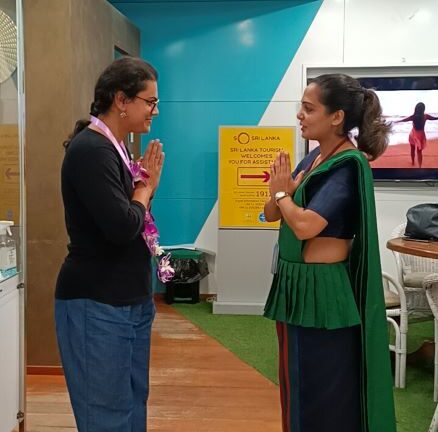
How to get from Colombo Airport to the city?
The airport is about 32 kilometers from the centre of the capital and it’s best to take a taxi to your hotel. The time duration is approximately 40-45 minutes depending upon the location of your hotel.
More affordable option is the Colombo Express bus that connects the airport to the city. There could be a wait time of up to 30 minutes so as to accommodate maximum tourists. The tickets can be bought in the bus itself from the bus conductor using local currency. The bus runs between 5:30 am to 8:30 pm.
GETTING AROUND IN SRI LANKA
There are many ways to get around Sri Lanka – train, bus or taxi. How to travel in Sri Lanka out of these options around Sri Lanka depends on your budget, where you want to go, and how much time you have. If you are short on time, it is best to hire a taxi and driver between most of your destinations. If budget is the constraint then choosing the train is ideal.
Sri Lanka by train
Sri Lanka has an excellent transportation infrastructure, including trains that connect the south to north and east to west. All the major cities and towns are well connected. These trains are comfortable, mostly on time, and are a great way to explore the country. Trains are the primary mode of transportation between cities in Sri Lanka.
Railway tickets in Sri Lanka can be booked via the official website here.
Make sure you book train tickets at least a month in advance, especially during season time as the seats get filled quickly.
Within cities, tourists can use tuk-tuk, taxi and app based taxi – Uber.
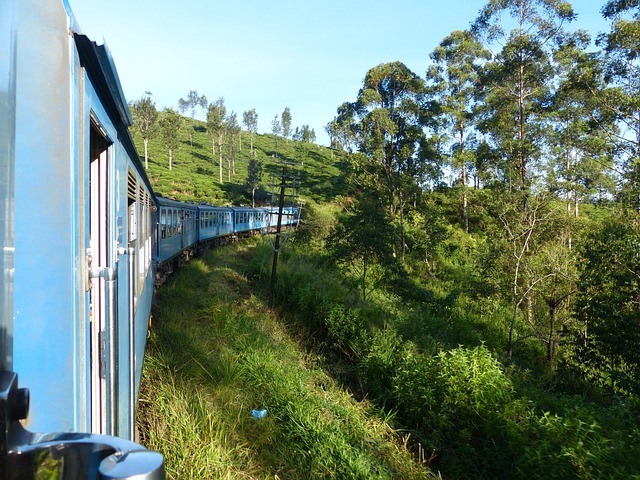
SRI LANKA ITINERARY
If you are a backpacker with time in hand, I would suggest spending 2 weeks in Sri Lanka. However, if you are a tourist wanting to explore the highlights of Sri Lanka then I would suggest atleast a week in Sri Lanka. Check out these itineraries as part of the Travel Guide to Sri Lanka.
One week Sri Lanka itinerary
Day 1: Explore Colombo
Day 2-3: Trip to Anuradhapura
Day 4: Day trip to Sigiriya
Day 5-6: Day trip to Kandy and Nuwara Eliya
Day 7: Day trip to Galle
2 weeks Sri Lanka itinerary
Day 1: Explore Colombo
Days 2 – 4: Dambulla, Sigiriya, Anuradhapura
Days 5 – 7: Kandy and Nuwara Eliya
Days 8 – 10: Ella, Yala
Days 11 – 13: Galle fort, Mirissa
If you are a traveler interested in certain types of tours in Sri Lanka such as adventure, heritage or beaches then itineraries can be customized accordingly. Some travellers cover only North Sri Lanka or South Sri Lanka and that is also doable.
Since I wanted to explore the heritage of Sri Lanka, this was my itinerary covering most of the UNESCO World Heritage Sites in Sri Lanka.
Heritage Circuit in Sri Lanka
Day 1: Colombo (Independence square, Lotus tower, Galle face beach)
Day 2: Explore Habarana and Minneriya National Park
Day 3: Anuradhapura
Day 4: Polonnaruwa
Day 5: Sigiriya
Day 6-7: Kandy
Read in detail here : Heritage Highlights of Sri Lanka
Adventure Circuit in Sri Lanka
Day 1: Colombo (Independence square, Lotus tower, Galle face beach)
Day 2: Kandy
Day 3: Nuwara Eliya
Day 4: Horton Plains
Day 5-6: Ella
Day 7: Bentota
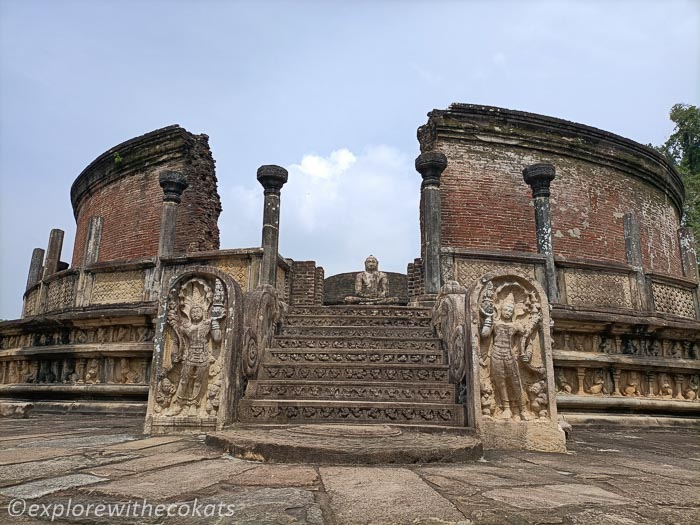
WHERE TO STAY IN SRI LANKA
Sri Lanka offers a wide range of accommodation options to suit different budgets.
Average price per night for stay:
Hostels: $15
Guest Houses: $20
Hotels: $30 – 50
Please find the recommendations for stays in Sri Lanka divided by location and sorted by price (lowest first) below.
Colombo
Stay Lost & Found Hostel
I heard about this hostel from a lot of backpackers and they had great reviews about it. It can be booked here.
City Stay By Sunrise
Located 1.5 km from Kollupitiya Beach, City Stay By Sunrise has air-conditioned rooms with free WiFi. All the rooms have a balcony. It can be booked here.
Taj Samudra
One of the most luxurious properties in Colombo, the hotel is located right across Galle Face Beach. The property has a pool, spa and indoor game options. There are 2 restaurants that cook up quite a storm with lip-smackingly delicious Sri Lankan and global cuisine.
I stayed here for a night and it was extremely comfortable and cozy. The buffet dinner and breakfast spread was amazing!
The property can be booked here.
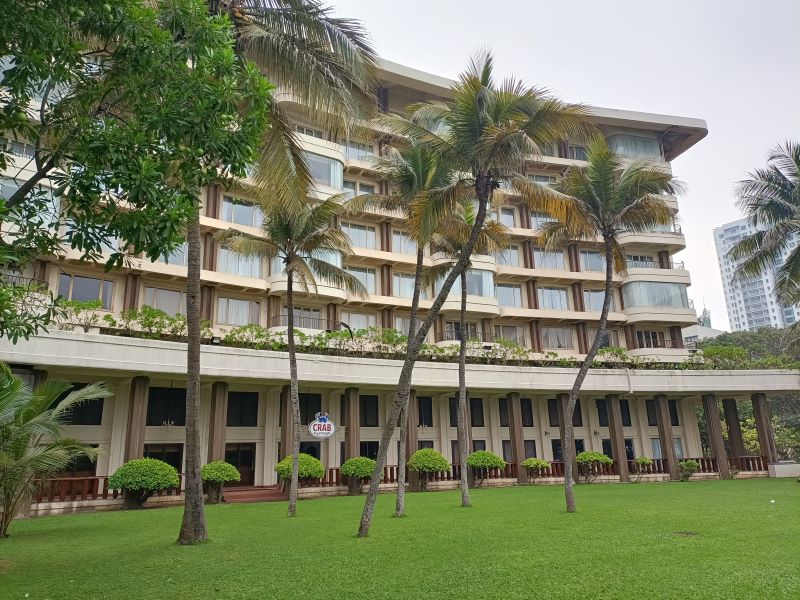
Kandy
Kandy Backpackers Hostel
Located very close to the city centre and just 1 km from the Kandy lake, Kandy Back Packer’s Hostel has air conditioned dorms and private rooms.. It also features stable and complimentary WiFi access and private parking, a common lounge, rooftop terrace, small library, shared kitchen and a year round outdoor pool. The property can be booked here.
Mahaweli Reach
Situated on the banks of Mahaweli river, this is a luxurious property. With lush gardens and a huge swimming pool, the hotel is popular among the locals for weddings too.
The rooms are extremely spacious and comfortable at Mahaweli Reach. And the food buffet at breakfast and dinner is incredible too. They even have live music at dinner making it a very special dining experience. The property can be booked here.
Mountbatten Bungalow
Mountbatten Bungalow is a restored colonial villa that still has its rustic charms. A 12-room property overlooking Kandy town, the surrounding of the property is a forest area and tea gardens.
The best feature is the 6 garden chalets that give a feeling of living in a forest guest room. The property can be booked here.
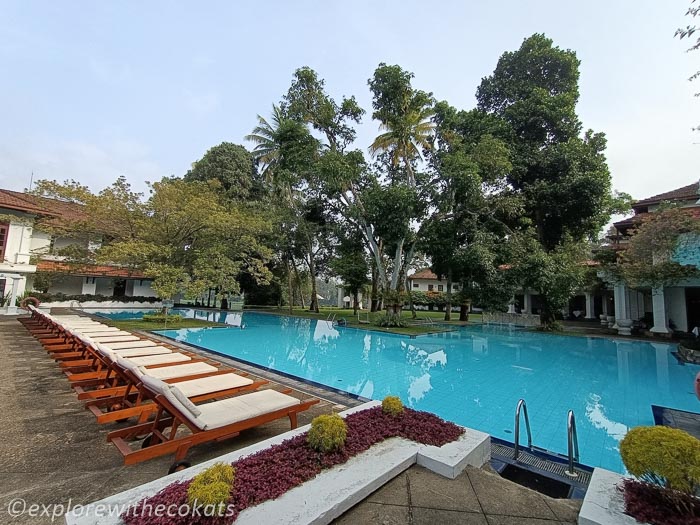
Habarana / Dambulla
Habarana is a great option while exploring heritage sites. One can choose to stay in Dambulla or Habarana area and do day trips to Dambulla caves, Sigiriya, Anuradhapura, and Polonnaruwa.
New Dambulla City Hostel
Located in Dambulla, there is a garden, shared lounge, terrace and free WiFi. They also offer Asian breakfast. The property can be booked here.
Jetwing Lake Dambulla
A sustainable property that is perfectly located along the tourist sites, I stayed here for 3 nights exploring the world heritage sites. It is an idyllic property with amazing views of a lake from all rooms. A huge infinity pool also is alluring. The food is delicious with a mix of Sri Lankan and world cuisine.
The property can be booked here.
Ariya Rest House
It is a family-run homestay near Polonnaruwa. The food was one of the best I had during my entire trip to Sri Lanka. There are various rooms that sleep 2 pax, 3 pax and even 5 pax. The rooms overlook a beautiful homegrown garden. Highly recommended! The property can be booked here.
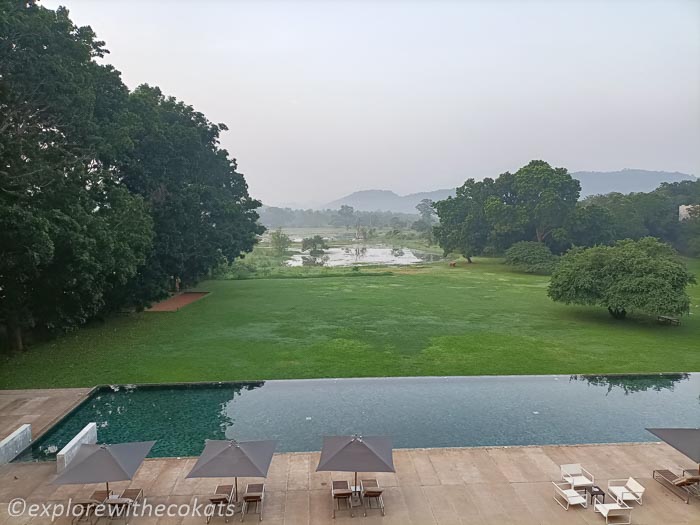
BUDGET FOR SRI LANKA TRAVEL
The amount of money you spend in a country completely depends on how soon you book your flight tickets, number of days you plan to do, the kind of hotels you stay in, the type of restaurants you visit, and the amount of shopping you do. However, Sri Lanka is an extremely affordable country in general.
You can find nice luxury hotels for less than $100 per night. Hostels can be hit or miss, so if you’re on a budget I suggest opting for AirBnB apartments in Colombo and guest houses in Polonnaruwa.
Food is incredible everywhere you go. I could literally go to Sri Lanka for just the food! You can get delicious street food for $1-$3. Sit down meals at nice restaurants cost approximately $7 – 10 per head.
Renting a car with a driver costs approximately $100 for 1 day. You can negotiate the cost of excursions with tour agents or guides. Rates are competitive and affordable.
SRI LANKA FOOD GUIDE
Sri Lanka travel guide cannot be complete without the mention of food!
When it comes to food in Sri Lanka, it is a culinary heaven that’s sure to tantalize your taste buds. Sri Lankan cuisine has a rich history, blending elements of Portuguese, English, Malay, Indonesian, Indian, and other Southeast Asian cuisines.
While fish and meat is found in most of the Sri Lankan traditional food, there are ample varieties of vegetarian dishes. South Indian dishes such as Dosa and Idli with sambar are found almost everywhere.
If you are wondering what to eat in Sri Lanka or best Sri Lankan food to try then check out this list. I am sticking to the most popular vegetarian options, since I am a vegetarian but there are many meat options too. Food travel guide to Sri Lanka.
Rice and Curry
Rice and Curry is the national dish of Sri Lanka and the staple food. It is eaten for meals. In restaurants there are generally 3 types of rice – boiled rice, fried rice or red rice. And curry is generally dhal (lentils) or chicken curry. There are ample side dishes like salads.
The best way to eat it is, scoop everything on a plate. Mix the rice and curry and keep having side dishes in between the bites. The local way to eat it is to mix everything together, add the pappadam and eat it with your hands.
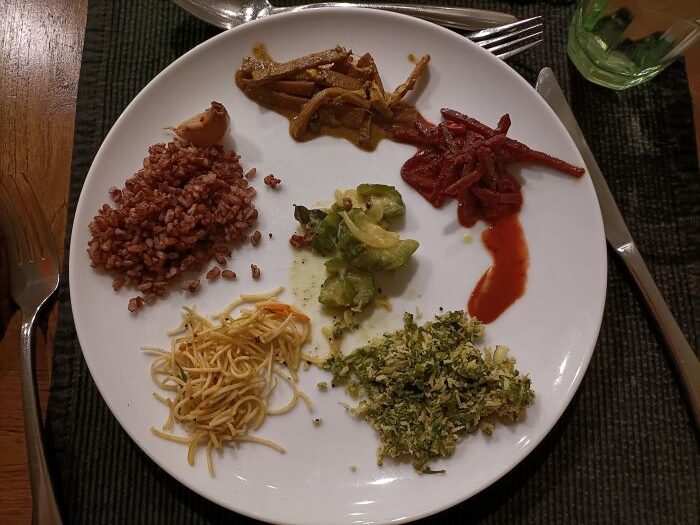
Kottu Roti
An extremely popular Sri Lankan street food dish is kottu. It comprises shredded pieces of Sri Lankan godamba roti that is flaky in nature and is stir fried with an assortment of spices and a choice of vegetables or sometimes meat.
Egg Hoppers
Hoppers which are also known as appa, are an iconic food of Sri Lanka. It uses a pancake-like batter which is made with all purpose flour and coconut milk. The hoppers are cooked in small “wok” like rounded pans so the dough cooks thick and soft on the bottom, and thin and crunchy around the edges. An egg is added in the middle until it cooks.
String Hoppers
String hoppers are made from a thicker rice flour based batter, squeezed into thin noodles, and then steamed. String hoppers are normally eaten for breakfast or dinner, along with a variety of different curry.
Sambol
Sambol is a condiment that accompanies Sri Lankan rice, curries and flatbreads. It looks like a salad cum chutney and can be dry or watery depending upon the main ingredient. There are atleast 3 sambol served during a Sri Lankan meal. There are different types of sambol – coconut, onion, gotukola (pennywort), beetroot, and so many others. Sambol is made by cutting or pounding the main ingredient and adding spices, salt and coconut to it.
King Coconut
Lining the side of the streets is the orange colored coconut called the king coconut. They are sweeter and even cheaper than packaged water bottles and so refreshing in this hot and humid country!
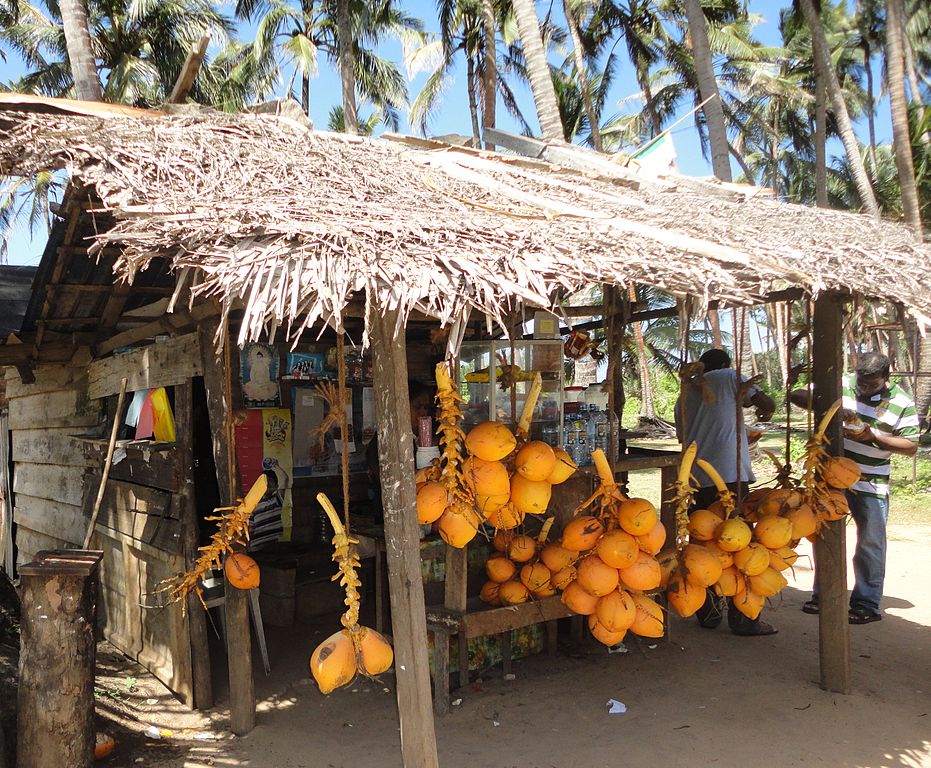
Woodapple Juice
Woodapple juice in Sri Lanka is extremely popular. It is served with traditional Sri Lankan food in restaurants. It tastes similar to tamarind.
Fruits
Being a tropical country, Sri Lanka is home to a diverse array of fruits that are both delicious and nutritious. Some of the most popular fruits grown in the country include pineapple, watermelon, rambutan, jackfruit and mango. Fruits are generally offered as dessert most meals, served with honey or plain.
I had the sweetest and juiciest pineapples here everyday for breakfast and dessert and they should not be missed.
Tea
Sri Lanka (formerly known as Ceylon) is one of the world’s leading producers of tea. Tea is part of the social culture in Sri Lanka and offered post meal or during the day. Black tea, milk tea as well as ginger tea are all popular and widely available choices.
It is typically made from black tea leaves, which are grown in the mountains of Kandy and nearby areas. The tea leaves are hand-picked and then processed using traditional methods. The resulting tea is rich in flavor and aroma, and is often served with sugar or honey. It is considered a symbol of hospitality and is often served to guests as a sign of welcome.
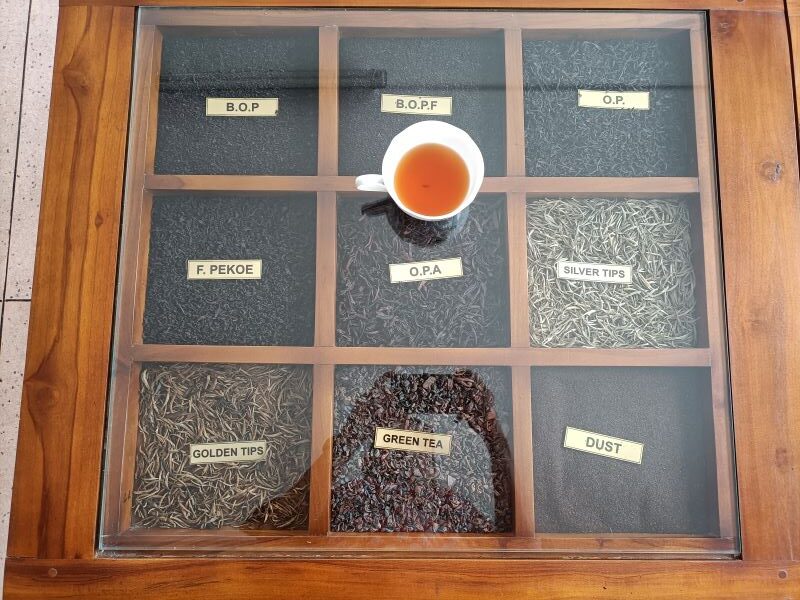
BEST TIME TO VISIT SRI LANKA
The best time to visit Sri Lanka is during the late winter to spring season, specifically December through March. These months offer dry and comfortable weather, making it ideal for exploring the country’s many historic sites and cultural attractions.
Avoiding the summer months can also help you avoid the high temperatures and humidity that can make sightseeing more difficult.
WHAT TO PACK FOR SRI LANKA
When planning a trip to Sri Lanka, it’s important to consider the cultural customs and climate of the country. As it is a relatively conservative country, it is best to dress modestly, particularly when visiting religious sites such as temples.
When visiting religious sites, you need to cover your shoulders and knees. Outside of the religious sites, sleeveless tops, shorts or knee-length dresses are mostly fine.
In terms of climate, summers can be quite hot, so it’s essential to pack sunscreen, a hat, and sunglasses to protect yourself from the sun. Pack light and airy clothing that can help you to stay cool during the daytime. Always carry a reusable water bottle preferably with a water filter to keep yourself hydrated. Other items to consider packing are a small first aid kit.
LANGUAGE
The main language spoken in Sri Lanka is Sinhalese language, also called Sinhala. It is spoken by the majority of the population and is used in official government and educational settings. Tamil is also widely spoken and understood, particularly in urban areas.
Most locals can speak English so you can get by without using Google translate in streets and tuk-tuk.
Key Phrases in Sri Lanka
Hello – Ayubowan (Aayu-bo-wan)
Thank you very much – Bohoma Istuti (Bo-hoh-mah Iss-too-tee)
Yes – Ow
No – Naa
Please – Karunakara (Karu-nah-kara)
How much is it – Meeka Kiyadha
Okay/Very Good- Hari Hondai
How are you?- Kohomadhe
I Don’t Speak Sinhala- Singhala Danna Naa
Wait a Minute – Poddak Inna
What is your name – Nama mokakda
My name is – Mage nama
Delicious – Hari rasai / rasavat
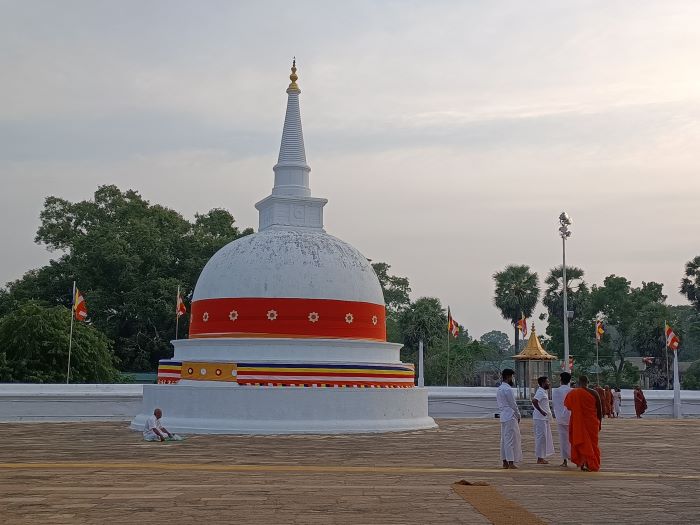
FREQUENTLY ASKED QUESTIONS ABOUT SRI LANKA
Is Sri Lanka worth visiting?
Yes! Sri Lanka is a great destination for tourists for many reasons – from ancient civilisations, incredible wildlife, tea plantations, a stunning coastline and delicious cuisine. Although many people opine that it is very similar to Tamil Nadu and Kerala in India in terms of culture, food and nature. But only when you travel here do you know the difference.
The country also has a visa-free or e-visa process available. This makes it easy for travelers to plan their trip and obtain the necessary documents within a short period of time.
Finally, Sri Lanka is a budget-friendly destination, with the cost of travel being relatively low. With a daily average travel budget of around $50-75 per day, travelers can enjoy all that the country has to offer without breaking the bank. All of these factors combined make Sri Lanka an excellent destination for tourists.
Is travel to Sri Lanka safe?
Yes! Sri Lanka is considered a safe destination for tourists. Incidents of violence against tourists are rare. Although the country is currently facing economic and political issues, the tourism industry is running fairly well and they are promoting the country with great discounts at hotels. I visited in November 2022 and did not see any issues in Sri Lanka.
It’s worth noting that as in any other place, tourists should always be aware of their surroundings, and keep an eye on their personal belongings, especially in crowded areas or on public transportation. Avoid carrying a lot of cash, and keep copies of your passport and other important documents in a safe place. It is also recommended to avoid walking alone in isolated or poorly lit areas at night.
Overall, Sri Lanka is a safe destination for tourists, and by following basic safety precautions, travelers can have an enjoyable and memorable experience exploring the country’s rich culture and history.
How many days do you need in Sri Lanka?
As mentioned in this Sri Lanka travel guide multiple times before, when planning a trip to Sri Lanka, it’s important to consider how much time you have available and what you want to see and do. A typical itinerary for a first-time visitor should be 7-10 days in Sri Lanka, allowing you to see the main highlights of the country.
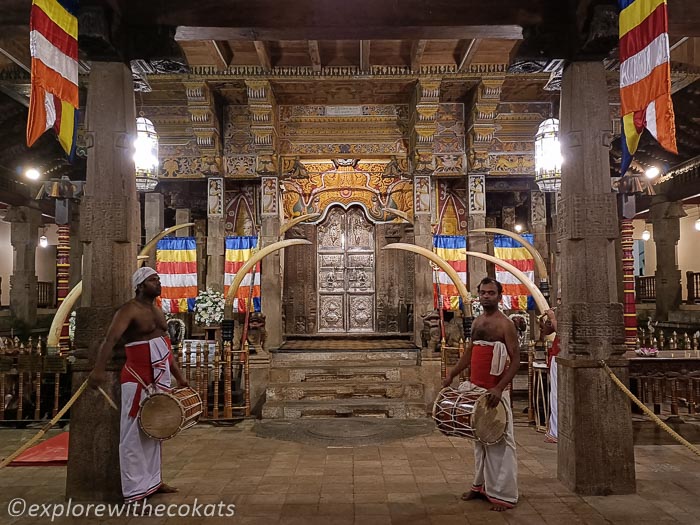
Do you need a guide in Sri Lanka?
The small island is proud of eight UNESCO World Heritage sites, and one can understand the history well if there is a guide with you. Although tourists can hire local guides at each tourist destination who offer services in many languages, I suggest that having a guide on the entire trip is beneficial as one can visit some offbeat spots. The guides also know good places to eat and stay.
I highly recommend Marcus Fernando who has tons of knowledge about every site and place. He can be reached at +94 777305587.
Is travel to Sri Lanka cheap?
Yes. Owing to the currency conversions (320 Sri Lankan Rupee LKR ~ 1 USD ~ 80 INR) and lower cost of living, it’s more budget-friendly to travel to Sri Lanka. If you opt for budget-friendly accommodations such as homestays or guesthouses, you can expect to spend less than $50 per day.
What should you avoid in Sri Lanka?
It is advisable to avoid drinking water from the tap. Always ask the hotel staff for filtered drinking water. In Sri Lanka the restaurants, hotels and cafes give the option of serving water hot or cold with every meal. This water is not chargeable.
Drinking culture in Sri Lanka
Sri Lanka has a strong drinking culture – beer was introduced by foreign captives and it has stayed here ever since. The island’s two staple forms of alcohol are lager and arrack. Arrack is a distilled alcoholic drink, made from the fermented sap of coconut flowers or sugarcane, or grain.
Is a Covid-19 test needed to enter Sri Lanka?
As of May 2023, you don’t need a Covid test. But it’s always better to check the embassy website in your country to get the latest information.
FINAL THOUGHTS ON SRI LANKA TRAVEL GUIDE
In conclusion, Sri Lanka is an excellent destination for travelers who are looking for a unique blend of culture, history, food and adventure. Also, the country is budget-friendly and easy to navigate, with well-developed transportation infrastructure, making it easy to get around between cities. Additionally, Sri Lanka is considered a safe destination for families and solo female travellers.
SUSTAINABLE TIPS FOR TRAVELING TO SRI LANKA
- Carry your own refillable water bottle. Thankfully most hotels in Sri Lanka use a glass water bottle for guest rooms so it is easy to fill up your bottle while traveling. Avoid purchasing PET water bottles unless absolutely necessary.
- Do not trash the heritage site with wrappers and uneaten food. Use designated areas and right-colored bins for disposing of waste.
- Be mindful of all the signs and follow them respectfully.
- Do not feed the local monkeys.
- Respect the ancient structures of temples and other structures by not sitting on them.
- Respect the places which prohibit photography.
- Do not write on the pillars and walls of archeological sites and temples.
I hope this Sri Lanka travel guide helps you plan a trip to the island country. Do you have more questions? Write to me in the comment below and I will reply.
Disclaimer: This post contains affiliate links. It means it adds no extra cost to you if you book through the link but I get a referral bonus which helps me earn a little to keep this website up and running.
PIN THIS POST!
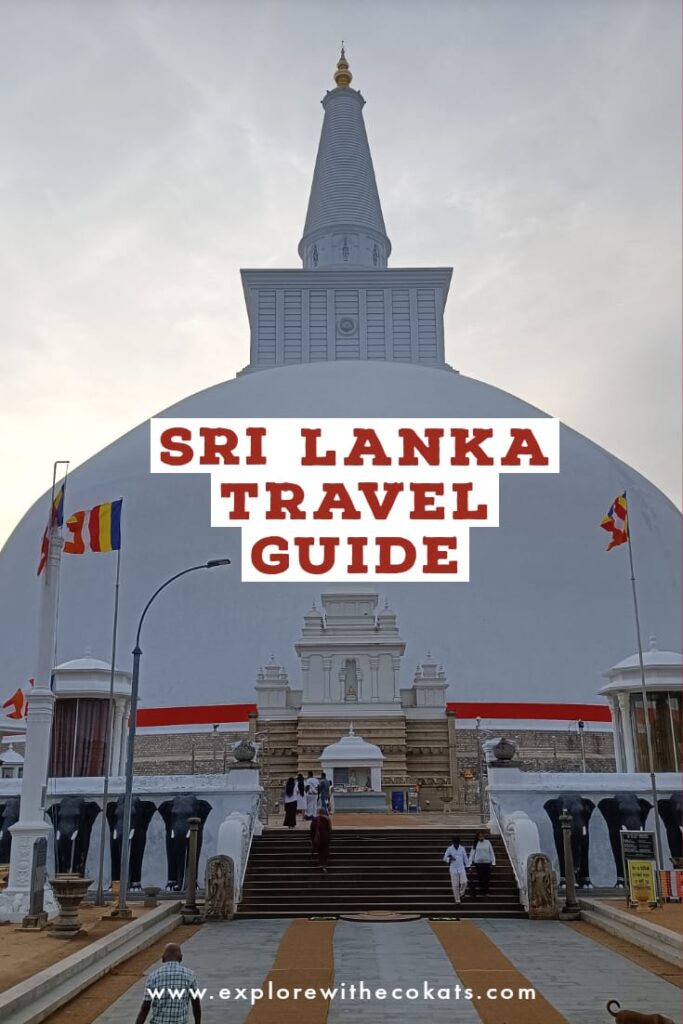
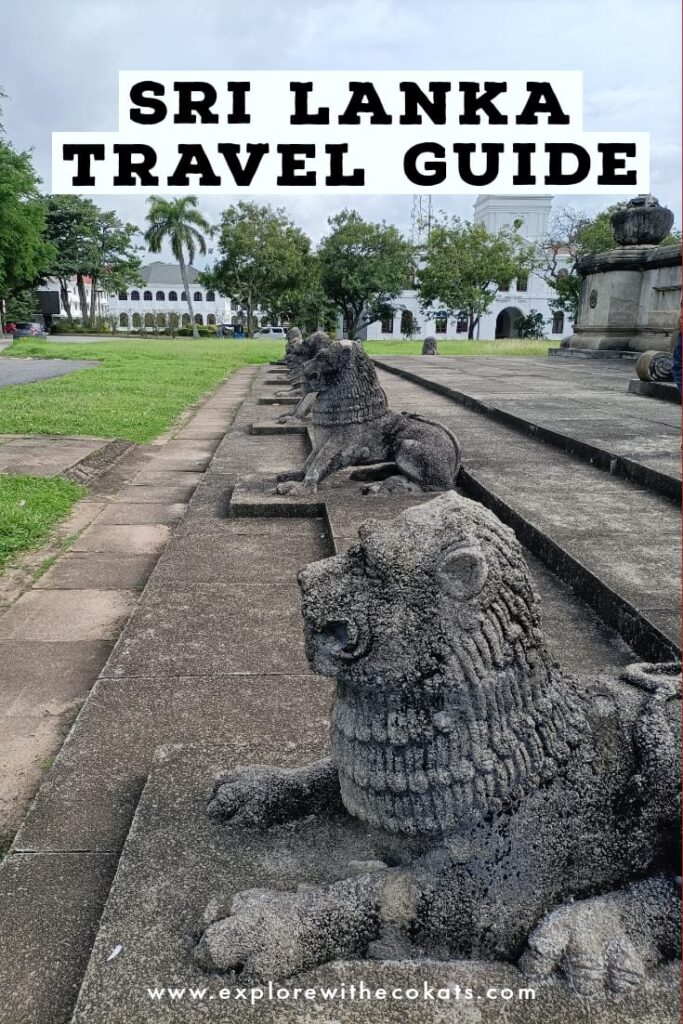
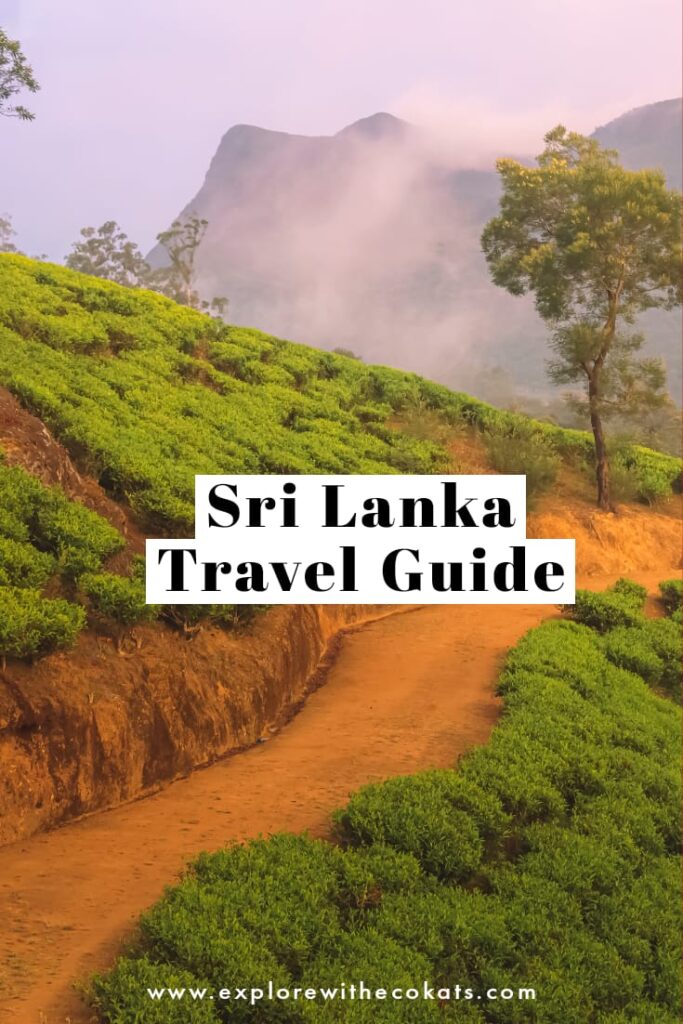

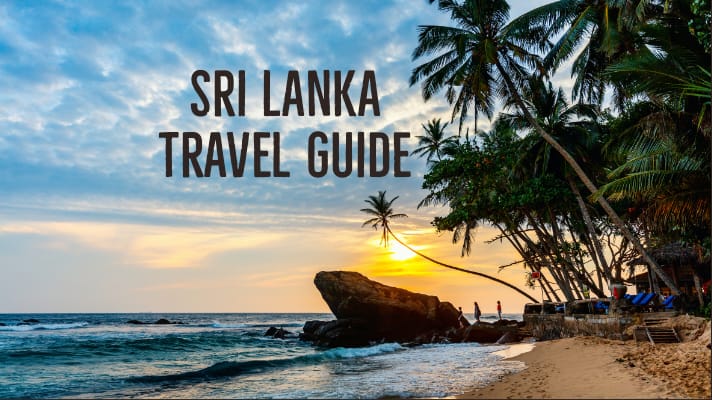
1 comment
I love to drink coconut milk out of the husk when I visit Caribbean islands. I would definitely sample the King Coconut juice!